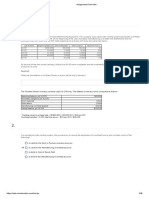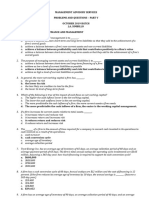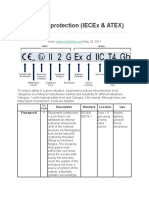CHAPTER 7: The Balanced Scorecard: A Tool To Implement Strategy The Balanced Scorecard Features of A Good Balanced Scorecard
CHAPTER 7: The Balanced Scorecard: A Tool To Implement Strategy The Balanced Scorecard Features of A Good Balanced Scorecard
Uploaded by
Phia TeoCopyright:
Available Formats
CHAPTER 7: The Balanced Scorecard: A Tool To Implement Strategy The Balanced Scorecard Features of A Good Balanced Scorecard
CHAPTER 7: The Balanced Scorecard: A Tool To Implement Strategy The Balanced Scorecard Features of A Good Balanced Scorecard
Uploaded by
Phia TeoOriginal Title
Copyright
Available Formats
Share this document
Did you find this document useful?
Is this content inappropriate?
Copyright:
Available Formats
CHAPTER 7: The Balanced Scorecard: A Tool To Implement Strategy The Balanced Scorecard Features of A Good Balanced Scorecard
CHAPTER 7: The Balanced Scorecard: A Tool To Implement Strategy The Balanced Scorecard Features of A Good Balanced Scorecard
Uploaded by
Phia TeoCopyright:
Available Formats
CHAPTER 7: The balanced scorecard: A tool to 4.
Innovation and Learning – measures of the
implement strategy firm’s ability to develop and utilize human
resources to meet the strategic goals now
The Balanced Scorecard and into the future.
■ Translates the organization's mission and Features of a Good Balanced Scorecard
strategy into a set of performance measures
that provides a framework for implementing 1. The balanced scorecard should tell the story
strategy. of a company’s strategy by articulating a
sequence of cause-and-effect relationships.
■ It is used to measure the company's health or
performance. 2. It helps to communicate the strategy to all
members if of the organization by
■ The scorecard measures organization's translating the strategy into a coherent and
performance from four perspectives: linked set to understandable and measurable
financial, customer, internal processes, and operational targets.
learning and growth.
3. In for-profit companies, the balanced
■ Strategic information using critical success scorecard places strong emphasis on
factors such as growth in sales and earnings, financial objectives and measures.
cash flow, stock price, market share, product
quality, customer satisfaction, and growth 4. The balanced scorecard should focus only
opportunities provides a road map for a firm on key measures to be used by identifying
to chart its competitive course and serves as only the most critical ones.
a benchmark for a competitive success.
5. The scorecard should highlight suboptimal
■ To emphasize the importance of using tradeoffs that managers may make when
strategic information, both financial and they failed to consider operational and
nonfinancial, accounting reports of a firm's financial measure together.
performance are now often based on critical
Pitfalls in Implementing a Balanced Scorecard
success factors in different dimensions.
1. Don’t assume the cause-and-effect linkages
■ Financial performance measures -
are precise.
summarize the results of past actions and are
important to a firm's owners, creditors, 2. Don’t seek improvements across all of the
employees and so forth. measures all of the time.
■ Nonfinancial performance measures - 3. Don’t use only objective measures in the
concentrate on current activities which will balanced scorecard.
be drivers of future financial performance.
4. Don’t fail to consider both costs and benefits
Four Perspectives of the Balanced Scorecard of initiatives before including these
objectives in the balanced scorecard.
1. Financial Perspective – measures of
profitability and market value among others, 5. Don’t ignore nonfinancial measures when
as indicators of how well the firm satisfies evaluating managers and employees.
its owners and shareholders.
6. Don’t use too many measures.
2. Customer Satisfaction – measures of
quality service and low cost, among others,
as indicators of how well the firm satisfies
its customers.
3. Internal Business Processes – measures of
the efficacy and effectiveness with which the
firm produces the product or service.
Evaluating The Success Of A Strategy
Assume the following operating incomes: Internal Business Processes Performance
Year 2003 Year 2004 Delivery cycle time – The amount of time from when
an order is received from a customer to when the
Revenues: completed order is shipped is called delivery time
(1,000,000×$26) $26,000,000 cycle.
(1,100,000×$24) $26,400,000 Throughput (Manufacturing Cycle) time – The
amount of time required to turn raw materials into
Expenses: completed products is called throughput time or
manufacturing cycle time. It is made up of process
Materials 4,050,000 3,631,320
time, inspection time, move time, and queue time.
Other 16,000,000 16,000,000
Process time – The amount of time work is actually
Operating income $5,950,000 $6,768,680
done on the product.
How can the increase in operating income of
Inspection time – The amount of time spent ensuring
$818,680 be evaluated?
that the product is not defective.
Growth Component
Move time – The time required to move material or
Revenue effect of growth component = (Actual partially completed products from workstation to
units of output sold in 2004 - Actual units of output workstation.
sold in 2003) x Output price in 2003
Queue time – The amount of time a product spends
Cost effect of growth component = (Actual units of waiting to be worked, to be moved, to be inspected,
input or capacity that would have been used in 2003 or to be shipped.
to produce year 2004 output assuming the same
Manufacturing Cycle Efficiency – Through
input-output relationship that existed in 2003 - Actual
concerted effort to eliminate the non-value-added
units or capacity to produce 2003 output) x Input
activities of inspecting, moving, and queuing to
prices in 2003
reduce their throughput time to only a fraction of
Price-Recovery Component previous level.
Revenue effect of price-recovery component = Manufacturing Cycle Efficiency Formula
(Output price in 2004 – Output price in 2003) ×
MCE = Value Added Time (or Process Time)
Actual units of output sold in 2004
Manufacturing Cycle Time
Cost effect of price-recovery component = (Input
prices in 2004 – Input prices in 2003) x Actual units where:
of inputs or capacity that would have been used to
produce year 2004 output assuming the same input- Manufacturing cycle time= Process time + Inspection
output relationship that existed in 2003 time + Move time + Queue time
Productivity Component
Productivity component = (Actual units of inputs or
capacity to produce year 2004 output - Actual units of
inputs or capacity that would have been used to
produce year 2004 output assuming the same input-
output relationship that existed in 2003) x Input
prices in 2004
You might also like
- EPA07 Maxxforce 7 Diagnostic Manual-2Document232 pagesEPA07 Maxxforce 7 Diagnostic Manual-2Jhon Constantine100% (8)
- Carrier Transicold 69rg15 130w 01Document78 pagesCarrier Transicold 69rg15 130w 01HeverzonYairPeñalozaLozano100% (1)
- Financial Controller 1 Quiz 5 QuestionsDocument1 pageFinancial Controller 1 Quiz 5 QuestionsWen Capuno0% (2)
- CHAPTER 3: Fundamental Concepts and Tools of Business FinanceDocument19 pagesCHAPTER 3: Fundamental Concepts and Tools of Business FinancePhia TeoNo ratings yet
- Buss. Combi PrelimDocument8 pagesBuss. Combi PrelimPhia TeoNo ratings yet
- Management Control and Strategic Performance Measurement Strategic Investment Units and Transfer PricingDocument68 pagesManagement Control and Strategic Performance Measurement Strategic Investment Units and Transfer PricingPhia Teo100% (1)
- HAZOP ReportDocument27 pagesHAZOP ReportMuhammad.Saim100% (5)
- MS3000 Brochure GBDocument4 pagesMS3000 Brochure GBRudolf SteinerNo ratings yet
- Problem 1: Solution Guide - Requirement 1Document4 pagesProblem 1: Solution Guide - Requirement 1Lerma MarianoNo ratings yet
- Use The Following Information For The Next Two Questions.: Act1108 Financial Management Inventory Management - ExercisesDocument1 pageUse The Following Information For The Next Two Questions.: Act1108 Financial Management Inventory Management - ExercisesMaryrose SumulongNo ratings yet
- Chapter 16 - Consol. Fs Part 1Document17 pagesChapter 16 - Consol. Fs Part 1PutmehudgJasdNo ratings yet
- Roles of Accountants in SDLCDocument7 pagesRoles of Accountants in SDLCAngel Juan0% (1)
- Quiz On Chapter 13 Answer KeyDocument2 pagesQuiz On Chapter 13 Answer KeyCindy BitongNo ratings yet
- Fin Mar-Chapter9Document2 pagesFin Mar-Chapter9EANNA15No ratings yet
- Philippine Standards and Practice Statements (Final) PDFDocument4 pagesPhilippine Standards and Practice Statements (Final) PDFMica R.No ratings yet
- AIS Wk1PostActDocument4 pagesAIS Wk1PostActRose Anne BautistaNo ratings yet
- AlagangWency - Partnersip Dissolution Short QuizDocument1 pageAlagangWency - Partnersip Dissolution Short QuizKristian Paolo De LunaNo ratings yet
- INFOTECH Module 1Document17 pagesINFOTECH Module 1Phee JhayNo ratings yet
- 5Document46 pages5Navindra JaggernauthNo ratings yet
- ReSA Batch 46 ScheduleDocument1 pageReSA Batch 46 ScheduleMica TolentinoNo ratings yet
- CHAPTER I and IIDocument13 pagesCHAPTER I and IIPritz Marc Bautista MorataNo ratings yet
- AE 18 Financial Market Prelim ExamDocument3 pagesAE 18 Financial Market Prelim ExamWenjunNo ratings yet
- Intermediate Accounting 1 - Inventories Part 2Document5 pagesIntermediate Accounting 1 - Inventories Part 2Lien LaurethNo ratings yet
- Week 4 - Lesson 4 Cash and Cash EquivalentsDocument21 pagesWeek 4 - Lesson 4 Cash and Cash EquivalentsRose RaboNo ratings yet
- Sample Practice Exam 10 May Questions - CompressDocument16 pagesSample Practice Exam 10 May Questions - CompressKaycee StylesNo ratings yet
- For MidtermDocument107 pagesFor MidtermAngelica RubiosNo ratings yet
- Strat Cost Man Acctg ExamDocument12 pagesStrat Cost Man Acctg ExamPam G.No ratings yet
- TB21 PDFDocument33 pagesTB21 PDFJi WonNo ratings yet
- This Study Resource Was: Chapter 2-Professional Practice of Accountancy: An OverviewDocument5 pagesThis Study Resource Was: Chapter 2-Professional Practice of Accountancy: An OverviewNhel AlvaroNo ratings yet
- Accounting For LeaseDocument36 pagesAccounting For LeaseenajymiNo ratings yet
- Reorder PointDocument4 pagesReorder PointRosemarie CruzNo ratings yet
- Chapter 6 - Revenue CycleDocument54 pagesChapter 6 - Revenue CyclePhan Thị Trúc VyNo ratings yet
- IFRS 15 - Practice QuestionsDocument33 pagesIFRS 15 - Practice Questionswaqasqazi728No ratings yet
- STDM Class Partipation QandADocument6 pagesSTDM Class Partipation QandAZhaira Kim CantosNo ratings yet
- Capital BudgetingDocument3 pagesCapital BudgetingNiña FajardoNo ratings yet
- Qualifying ExamDocument60 pagesQualifying ExamMARK ANGELO PANGILINANNo ratings yet
- ACT23 Exam FinalsDocument9 pagesACT23 Exam FinalsLim JugyeongNo ratings yet
- Group 5 Problem 7 2Document6 pagesGroup 5 Problem 7 2Shieryl BagaanNo ratings yet
- Diagnostic Quiz On Accounting 2Document9 pagesDiagnostic Quiz On Accounting 2Anne Ford67% (3)
- Pa 114 - Project Management: Roderick Tuling Olivar, MPA (CAR), CHRADocument10 pagesPa 114 - Project Management: Roderick Tuling Olivar, MPA (CAR), CHRACharibelle AvilaNo ratings yet
- Tax Exams 1-2Document16 pagesTax Exams 1-2Dan MichaelNo ratings yet
- Name: Date: Subject: Section and Time:: Problem 1Document16 pagesName: Date: Subject: Section and Time:: Problem 1Marie GarpiaNo ratings yet
- An Information Systems FrameworkDocument30 pagesAn Information Systems FrameworkDr. Mohammad Noor AlamNo ratings yet
- Cost Concepts and Analysis: Management Advisory ServicesDocument7 pagesCost Concepts and Analysis: Management Advisory ServicesAlexander QuemadaNo ratings yet
- Govcon Answers Week 2Document4 pagesGovcon Answers Week 2kateangel ellesoNo ratings yet
- FAR 103 ACCOUNTING FOR RECEIVABLES AND NOTES RECEIVABLE PDF PDFDocument4 pagesFAR 103 ACCOUNTING FOR RECEIVABLES AND NOTES RECEIVABLE PDF PDFvhhhNo ratings yet
- Errors and Irregularities in The Transaction Cycles of The Business EntityDocument5 pagesErrors and Irregularities in The Transaction Cycles of The Business EntitysissyNo ratings yet
- MS03 09 Capital Budgeting Part 2 EncryptedDocument6 pagesMS03 09 Capital Budgeting Part 2 EncryptedKate Crystel reyesNo ratings yet
- Questions: Buy This Full Document at Http://test-Bank - UsDocument35 pagesQuestions: Buy This Full Document at Http://test-Bank - UsSami KhanNo ratings yet
- Competitive Markets: T T T T Multiple Choice QuestionsDocument12 pagesCompetitive Markets: T T T T Multiple Choice QuestionsLance TizonNo ratings yet
- Chapter 1 Fundamental Principles of ValuationDocument14 pagesChapter 1 Fundamental Principles of ValuationMae ann LomugdaNo ratings yet
- 6 Organizational Innovations: Total Quality Management Just-In-Time Production System PDFDocument5 pages6 Organizational Innovations: Total Quality Management Just-In-Time Production System PDFAryan LeeNo ratings yet
- Week 10 Control Self AssessmentDocument24 pagesWeek 10 Control Self AssessmentMark Angelo BustosNo ratings yet
- MNGT 21 - Management Science Decision TreeDocument1 pageMNGT 21 - Management Science Decision TreeKlaryz D. MirandillaNo ratings yet
- PCDocument7 pagesPCRinokukunNo ratings yet
- Chapter 25 - AnswerDocument18 pagesChapter 25 - AnswerAgentSkySkyNo ratings yet
- Drill#1Document5 pagesDrill#1Leslie BustanteNo ratings yet
- TFAR2303 - Investment in Debt Securities (With Answers)Document4 pagesTFAR2303 - Investment in Debt Securities (With Answers)Bea GarciaNo ratings yet
- Chapter 28: Depletion Pfrs/Ifrs 6: Financial Reporting For The Exploration and Evaluation of Mineral ResourcesDocument3 pagesChapter 28: Depletion Pfrs/Ifrs 6: Financial Reporting For The Exploration and Evaluation of Mineral ResourcesKaryl FailmaNo ratings yet
- Balanced ScorecardDocument14 pagesBalanced ScorecardLand DoranNo ratings yet
- NIKE Case AnalysisDocument2 pagesNIKE Case AnalysisRenceNo ratings yet
- Finman - Q2 Cost Os CaptDocument2 pagesFinman - Q2 Cost Os CaptJennifer RasonabeNo ratings yet
- CH06 Activity 1Document1 pageCH06 Activity 1norynNo ratings yet
- Chapter 16 - Securities Firms and Investment BanksDocument2 pagesChapter 16 - Securities Firms and Investment Banksmvlg26No ratings yet
- CHAPTER 7: The Balanced Scorecard: A Tool To Implement Strategy The Balanced Scorecard Features of A Good Balanced ScorecardDocument2 pagesCHAPTER 7: The Balanced Scorecard: A Tool To Implement Strategy The Balanced Scorecard Features of A Good Balanced ScorecardPhia TeoNo ratings yet
- Chapter 7 THE BALANCED SCORECARDDocument5 pagesChapter 7 THE BALANCED SCORECARDDiana Mark AndrewNo ratings yet
- Basic Concepts of The Balanced ScorecardDocument4 pagesBasic Concepts of The Balanced ScorecardAlleana CruzNo ratings yet
- Ethics Reviewer11Document8 pagesEthics Reviewer11Phia TeoNo ratings yet
- Buss. Combi PrelimDocument8 pagesBuss. Combi PrelimPhia TeoNo ratings yet
- ReviewerDocument14 pagesReviewerPhia TeoNo ratings yet
- Ethics ReviewerDocument3 pagesEthics ReviewerPhia TeoNo ratings yet
- Cis ReviewerDocument8 pagesCis ReviewerPhia TeoNo ratings yet
- The Good Life Learning OutcomesDocument4 pagesThe Good Life Learning OutcomesPhia TeoNo ratings yet
- Understanding The Entity and ItDocument14 pagesUnderstanding The Entity and ItPhia TeoNo ratings yet
- Aud Theory ReviewerDocument6 pagesAud Theory ReviewerPhia TeoNo ratings yet
- Ibat ReviewerDocument18 pagesIbat ReviewerPhia TeoNo ratings yet
- S C MDocument3 pagesS C MPhia Teo50% (2)
- Fe Del MundoDocument2 pagesFe Del MundoPhia TeoNo ratings yet
- Pastel Mozzo: 7 Kingfisher ST., Zabarte Road, Quezon CityDocument4 pagesPastel Mozzo: 7 Kingfisher ST., Zabarte Road, Quezon CityPhia TeoNo ratings yet
- CHAPTER 7: The Balanced Scorecard: A Tool To Implement Strategy The Balanced Scorecard Features of A Good Balanced ScorecardDocument2 pagesCHAPTER 7: The Balanced Scorecard: A Tool To Implement Strategy The Balanced Scorecard Features of A Good Balanced ScorecardPhia TeoNo ratings yet
- RecommendationDocument2 pagesRecommendationPhia TeoNo ratings yet
- Looking For Aspiring CandidatesDocument1 pageLooking For Aspiring CandidatesPhia TeoNo ratings yet
- Resume Pro FormaDocument3 pagesResume Pro FormaPhia TeoNo ratings yet
- Types of Protection (Iecex & Atex) : Description Standard Location Use FlameproofDocument4 pagesTypes of Protection (Iecex & Atex) : Description Standard Location Use FlameproofNajem A. SakorNo ratings yet
- Istart Brochure PDFDocument8 pagesIstart Brochure PDFmohammed moussNo ratings yet
- MM Project ProposalDocument4 pagesMM Project ProposalSikander AzamNo ratings yet
- Final Notebook 10 3Document2 pagesFinal Notebook 10 3api-335583967100% (1)
- Design of Distillation Sequence From Conventional To Fully Thermally Couple Distillation SystemDocument23 pagesDesign of Distillation Sequence From Conventional To Fully Thermally Couple Distillation SystemRinda Nur HidayatiNo ratings yet
- JAP60S10 SC 275-295 1000V【Australia CEC】Document2 pagesJAP60S10 SC 275-295 1000V【Australia CEC】MEL ANGELESNo ratings yet
- Compresor MYCOMDocument8 pagesCompresor MYCOMPEDRONo ratings yet
- Dattatraya Vairal (1.8 Yr Exp.) - Front End DeveloperDocument3 pagesDattatraya Vairal (1.8 Yr Exp.) - Front End DeveloperAnonymous kBI8dq2No ratings yet
- Carry Out Mensuration and CalculationDocument15 pagesCarry Out Mensuration and CalculationKaren Villapando LatNo ratings yet
- Uniflux Heater Brochure PDFDocument8 pagesUniflux Heater Brochure PDFMichael J. BaneNo ratings yet
- Vermeer D24x40Document2 pagesVermeer D24x40Jhon CanizalesNo ratings yet
- Duct Sizing - ReferenceDocument27 pagesDuct Sizing - ReferenceAnkurNo ratings yet
- Learning TheoriesDocument17 pagesLearning TheoriesGaoudam NatarajanNo ratings yet
- Broadcast Principles Week1Document4 pagesBroadcast Principles Week1TriciaAyanaCachoNo ratings yet
- List of Qualified Manufacturers Supplierss - July 2023-FinalDocument55 pagesList of Qualified Manufacturers Supplierss - July 2023-FinalArif KhanNo ratings yet
- Ammonia Machinery Room Ventilation Requirements Dtc-Engineering-bulletin-4Document11 pagesAmmonia Machinery Room Ventilation Requirements Dtc-Engineering-bulletin-4Sergio GarciaNo ratings yet
- CV Library Graduate No Experience CV TemplateDocument2 pagesCV Library Graduate No Experience CV Templateryusrina88No ratings yet
- EY Customer and Growth Capabilities Customer ExperienceDocument18 pagesEY Customer and Growth Capabilities Customer ExperiencearkadiiNo ratings yet
- Assa AbloyDocument31 pagesAssa AbloyPRAKASH CHANDRA AHIRNo ratings yet
- Tl-Wpa4220 Kit V1 Qig PDFDocument2 pagesTl-Wpa4220 Kit V1 Qig PDFΔημήτρηςNo ratings yet
- Position Papers 1 - Atmospheric Storage TanksDocument24 pagesPosition Papers 1 - Atmospheric Storage Tanksuserscribd2011No ratings yet
- Working With The Cold Box ProcessDocument21 pagesWorking With The Cold Box ProcessAnonymous iztPUhIiNo ratings yet
- VSA DTC Troubleshooting: 86-11Document2 pagesVSA DTC Troubleshooting: 86-11Ehcan KamplehNo ratings yet
- Jobs (FCCL)Document2 pagesJobs (FCCL)Muhammad Asif HussainNo ratings yet
- Canon IR2016 Error CodesDocument7 pagesCanon IR2016 Error CodesnafeesNo ratings yet
- 2 CE155 - MQT EarthworksDocument17 pages2 CE155 - MQT EarthworksAlbert SaludNo ratings yet











































































































